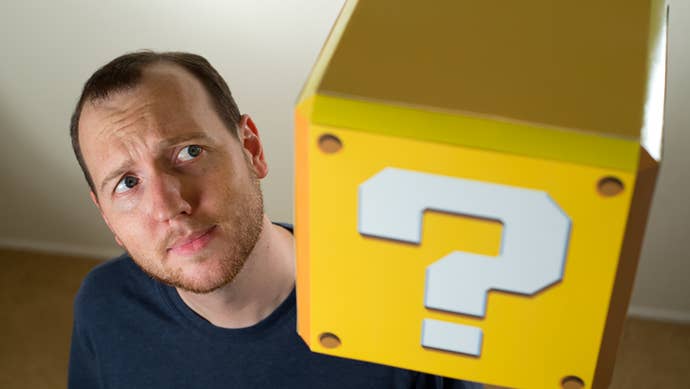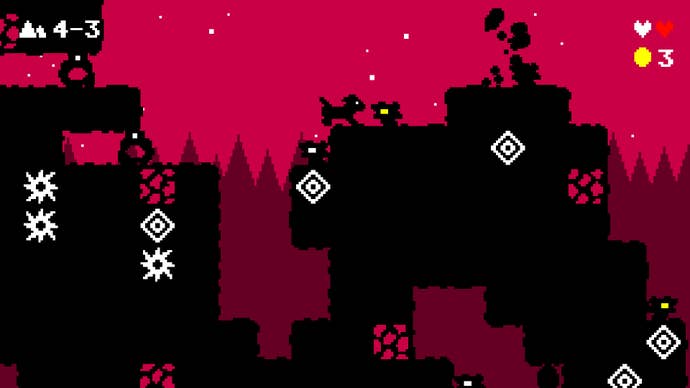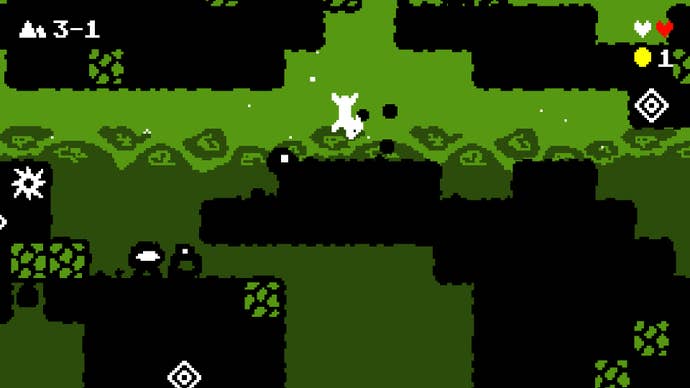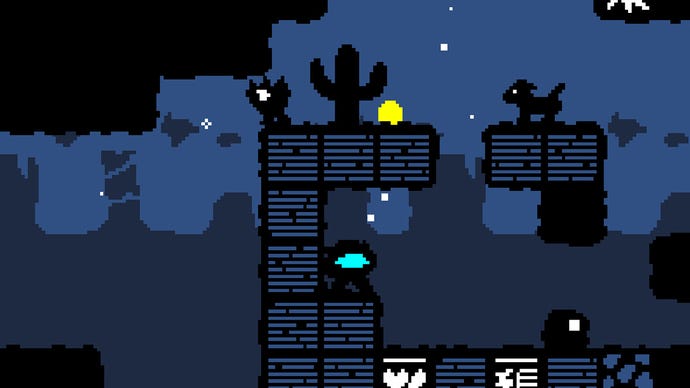Dig Dog Is A Cute Roguelike About Digging For Bones. It Was Also Developed Without Hands
How Rusty Moyher developed an entire game without using his hands.
This article first appeared on USgamer, a partner publication of VG247. Some content, such as this article, has been migrated to VG247 for posterity after USgamer's closure - but it has not been edited or further vetted by the VG247 team.
Rusty Moyher had been wanting to make games since he was a kid. In a pre-Google era, he'd go to the library and read about HyperCard, a software development tool for old Macintosh computers, and eventually started making some projects. He likens them to flip books with animation and point-and-click adventures—the only experiments he could tinker with before properly learning to program. Some 15 years later, with the emergence of prominent indie game developers, Moyher finally saw where he could fit into the space.
"It wasn't until 2010, 2011 when I started to see iPhone games and the emergence of indie and self-publishing games where people were like one or two man studios and I'm like 'Whoa, I'm a one or two man person,'" he says. "Like maybe I could do a project."
He quit his day job in 2011, and embarked on his first solo development project: Box Cat, an arcadey game about a cat shaped like a box (or box shaped like a cat, whatever you think is more appropriate) who wrecks everything in their path—particularly vehicles. At its core is something that's present in all of Moyher's work: despite being on modern devices, it harbors an adoration for the old, but never in a cloying nostalgia-baiting way. It's visible in his latest project too, the environment-destroying roguelike Dig Dog that released last year on Xbox One, PC, Mac, iOS, and last week came to Switch.
It's also Moyher's first project that he fully developed without using his hands.
In 2013 during development of the successfully Kickstarted project Retro Game Crunch (where he worked alongside Shaun Inman and Matt Grimm), he knew he had a problem. He had ignored his consistent wrist pain since he began programming full-time. With the ambition of Retro Game Crunch's original pitch of making six games in six months (which released in 2014 with seven games in total), itself an answer to the long-development cycles of Kickstarter games, the problem got much worse.
"By the third game my wrists were just destroyed, so I wasn't able to continue the project, which was super hard because I was letting my partners down, I was delaying the project," says Moyher, who develops most games under the alias Wild Rooster. "We were already kind of failing in our promise in terms of the timeline for release. And of course I was seriously injured and under financial stress too because I was not able to work and I was spending money on doctors as well. So it was really hard."
Around this time, Moyher began experimenting with finding ways to program that wouldn't make his newly diagnosed Repetitive Strain Injury worse. "I'm a very flexible person and that can be good for an athlete, but for me as I do the same thing over and over and over again my ligaments aren't as loose or as tight as they are in most people," he tells me of how the injury came to be, "and so it means it puts extra stress on my muscles and eventually things kind of wear out."
To get around it and still do the work he loves, Moyher looked into every unique tool imaginable. Vertical mice, Wacom tablets and pens, a roller mouse, even a U-shaped, vertically-inclined keyboard. While some tools helped more than others, Moyher still found himself in desperate need of something that could give him what he really needed: breaks.
"I wanted some way to be like, 'Yes, this is going to solve it,' because I was having back problems when I was working—this is unrelated, just chair stuff—I would have lower back pain, and I tried a bunch of different chairs," Moyher says. "Eventually I found a kneeling chair, and the kneeling chair totally solved all my back problems. I've been using a kneeling chair for 7, 8 years now and it's been perfect. I'm like, 'Wow! Can I find the kneeling chair of like being able to program, so I can work an eight hour day or longer without hurting myself?'"

Moyher discovered what he calls his "silver bullet:" voice coding. In speaking out code into a microphone, it translates into the Python programming language for games he would usually type. He formulated unique vocabulary to simplify his workflow too.
By the summer of 2016, Moyher, having partially used his new voice coding tools for some other projects, wanted to develop a game solely with it. In developing a game exclusively with voice coding, it would, ideally, drive him to improve the tools he was using for not just his adorable action roguelike's development, but for all development going forward.
"First of all, all of this work that I'm doing is like on the shoulders of other giants. People who have done [this before]," Moyher says. "I'm using speech recognition software made from Nuance, which is really good at just taking your voice and putting it into text on the screen. It's not really good at code, but it's really good at just natural voice. And then there's hacks on top of that that allow you to basically interrupt with what's happening underneath."
Moyher built his own personal vocabulary to quicken the coding process using DragonFly, which he used to create his own shortcuts, commands, and more. With his original vocab, he retrofits jargon into punchy words like lack, rack (each for right or left brackets), snap, and more. When he speaks his shortcuts into DragonFly, they materialize as scripted in the code.
"The challenge for me wasn't just kind of coming up with the commands, it was coming up with the commands and then remembering them, trying to get it to become second nature," Moyher explains. "And that just takes an enormous amount of time, because while I'm doing both those things, like building up the system and then trying to remember the system, I'm actually having to program a game at the same time. So it made the whole process very slow, but just sticking with it over a long period of time, now it's to the point where I'm like, 'Oh yeah like I can work doing this and it's as fast as I need it to be right now.'"

Programming, of course, isn't just typing in "weird symbols" (as Moyher says in layman terms); it's also about moving around a cursor. To get around this mouse-usage, Moyher purchased a pricey SmartNav 4, an infrared camera that sits on top of a computer and tracks movement reflected from glasses or a hat to move the cursor around in programs like Visual Studio—because in addition to coding, Moyher did all the art for Dig Dog too. The only thing he did with his hands the entire development was properly playtest using a controller, something that was unavoidable for the precision-minded roguelike. Using the headtracker to try and playtest simply wouldn't cut it.
He mentions briefly that he's moved onto an eyetracker device since Dig Dog's development, and the reason to me is immediately obvious: tilting your head to drag a cursor around can't be healthy, which is ironic for a device built for accessibility. "It's not normal right? You know, like, most people don't do that, like I'm using it a lot a lot," he says. "So the eye tracker, [the Tobii Eye Tracker 4C], seems to be a bit better for maybe the long term, but the smart mouse really did work well."
It's been over a year since Dig Dog released on PC, Mac, iOS, and Xbox One, though last week saw its debut on Nintendo Switch. The Switch version is still cheap, costing only $3.99, and it brings with it a new awards system where players can track their progress and unlock new color palettes too—a trend seen in other modern 8-bit games like Downwell. With a year-plus since the original release behind him, he's looking forward to catching up on sleep, even if for the time being he's still in "release mode" for its Switch iteration.
We hear often now about accessibility for people who play games, whether it's arguing for advocating for accessibility options for players or just in offering controllers like the recent Xbox Adaptive Controller. In the ongoing conversation, we don't hear enough about options and tools for game developers with disabilities. But with Moyher's work, and others before him, the old adage "anyone can make a game" is getting truer by the moment.

"I've been trying to be helpful but what helps me is not necessarily going to be the answer for everybody else when it comes to 'how do I stop hurting myself when I work,'" says Moyher of the response from other game developers and players who deal with similar disabilities. "So it's been fun to share, although I'm having to get used to sharing it. It's something where it's like I want to be, I don't know, I have to get used to the idea of like sharing personal things."
Moyher hopes he's helping people with his candidness, even if doing so is new to him. In an interview with Ars Technica in early 2018, Moyher went into depth on his workflow in the hopes that it would help others who want to explore voice coding as a potential avenue to develop games. In the lengthy, technical interview, he dives into the specific tools like DragonFly that helped make Dig Dog possible. And his primary motivator that got him through the long and experimental development process is, perhaps, something we can all find familiar.
"For me, I'm really driven by a desire to make and share things. And so I, basically, just want to continue to do that and I think that drive is really what pushes me to be able to find answers even if it's going to be a little bit harder. I guess it's because like I'm—I don't want to say like capital-a artist—but I guess I'm an artist. I just want to make things and share things. [...] I think that anybody can push themselves to be able to do a lot if they have that desire."










